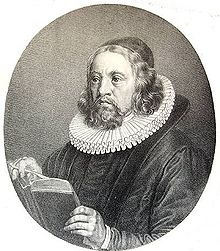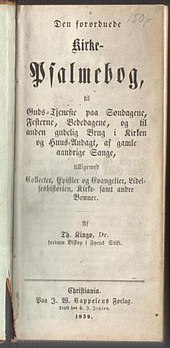Thomas Kingo
Thomas Hansen Kingo (born December 15, 1634 in Slangerup commune , † October 14, 1703 in Odense ) was a Danish Lutheran bishop and poet of hymns , the so-called Kingopsalmen .
Life
Thomas Kingo is the son of Karen Sørensdatter and the weaver Hans Thomsen Kingo, whose ancestors came from Scotland. Although coming from a humble background, they made it possible for their son to attend school in Slangerup and later in Frederiksborg , where he learned literary history , among other things , and graduated from high school in 1654. 1658 followed the theology exam .
At first he was tutor in Frederiksborg and from 1659 on at the Vedbygaard estate, where he wrote his first poems . In the Danish Biographical Lexicon (1887–1905) it is emphasized that the humor and the closeness to life of these poems were unusual for their time - but also for his later secular work .
In 1661 Thomas Kingo became assistant pastor and finally parish pastor in 1668 in his birthplace Slangerup. There he married the pastor's daughter Sille Balkenborg from Norway, who had three daughters from a previous marriage. The marriage remained childless and his wife died in 1670. He dedicated the sage Chrysillis, you min Verdens Guld (Chrysillis, you my gold of the world) to her. About four years later he married his manager's widow, Johanne Laurdsdatter Lund, who was 13 years older than him. This marriage was supposed to last 20 years, but is not described as happy, which his Danish biographer in the 19th century describes as normal for the time when marriages for love were not yet so important.
During those years he got into bitter conflict with the satirical poet Jacob Worm . Both wrote abusive verses on top of each other, of which Kingo's Kalot is the most famous poem. It appeared anonymously at the time. In addition, he wrote a number of poems during his time as parish priest, which can be divided into three categories:
- love poems
- Fatherland poems
- Spiritual poetry
The Danish Biographical Lexicon describes his secular poetry as not particularly outstanding, where the fog of tastelessness seldom clears and poetic inspiration comes to the fore . His patriotic verses mostly deal with the glorification of the absolutist ruler Christian V , which was not only common in Denmark at the time. These works are under significant influence from Germany.
Kingo's spiritual poetry (in Danish it is called psalm poetry ), on the other hand, enjoys a much higher priority. Here he broke new ground for his time, which was marked by a certain stagnation after the Reformation (in Denmark 1536). Although he was considered a capable pastor, this lively work was probably decisive for his being appointed Bishop of Funen in 1677 . In 1679 Kingo was admitted to the nobility. In 1682 he became a doctor of theology.
In 1683 he was commissioned by the king to publish a new hymn book, since the previous one by Hans Thomissøn (1569) was no longer considered to be in keeping with the taste of the time. After six years of work, the first part ( Vinterparten - winter part) of Danmarks og Norges Kirke forordnede Salmebog (prescribed hymn book for the Church of Denmark and Norway) was published. For this purpose, Kingo had set up his own print shop at his bishopric. The book contains 267 songs for the church year between the 1st of Advent and Easter , half of which are Kingo's own works. However, it did not come to the hoped-for extradition to all churches in the kingdom. Instead, the Den Forordnede Kirkepsalmebog appeared in 1699 , which still contained 85 Kingopsalms . Many of them are still in the hymn books of the Danish and Norwegian national churches and, like Grundtvig's hymns, are part of the Nordic spiritual heritage.
His wife Johanne died in 1694. At the age of 60, Kingo remarried. This time a 30 years younger woman, Birgitte Balslev, doctor's daughter from Odense. This marriage is described as happy but remained childless.
Thomas Kingo suffered in his last years of stones and erysipelas . He died in 1703 at the age of 68. His burial chapel, designed by Thomas Quellinus , is located in Fraugde Kirke near Odense .
Aftermath
While Kingo's work is considered the pinnacle of Danish Baroque poetry , his hymns are still part of the hymn books in Denmark and Norway today, and especially in the Faroe Islands they are a living part of the local cultural heritage - a musical genre in its own right. In Odense and Slangerup, monuments and epitaphs (such as by Thomas Quellinus ) remember the poet, but his greatest monument are the psalms that live on in Scandinavia today.
You, oh Lord, know best what I need,
happiness is in your hands too.
And
you can already see what works for me in every way ; my soul, what more do you want?
Only let God rule!
(Thomas Kingo: Nu rinder solen op af østerlide 1674)
Kingo's importance in the Faroe Islands

In the Faroe Islands , Kingo's hymn book from 1699 gained a meaning that can still be felt today. Based on the Kingopsalms, a separate genre of Faroese music developed , which did without the accompaniment of instruments such as the church organ until the 19th century , which only slowly found its way after the construction of the Faroese wooden churches . The German Faroe traveler Carl Julian von Graba wrote in his diary in 1828 , on a trip to Faroe to the Kingo songs of the Faroe Islands :
“The singing was the most terrifying thing I have ever heard in my life; everyone yells the first sound that comes to mind. "
Of course, this changes the meaning of the songs just as little as the respect Graba had elsewhere for the high level of spiritual education of the common people.
Around 1900 the Kingopsalms lost their dominant position in the spiritual life of the Faroese , but were still kept alive locally as the hymns.
The municipality of Tjørnuvík in the far north of the island of Streymoy , where an organ was only introduced in 1983, is known in this context . For nearly three centuries, Kingo was primarily relied on here. The village's Kingo Choir played a central role in the House of the North's project to register the Faroese Kingo singing tradition in 1988. The Suite Kingoløg by Kristian Blak was released as early as 1984, based on old songs from various villages.
The Kingo group from Tjørnuvík not only performed at the 2001 national art festival, but was invited to the celebrations there by the Copenhagen bishop in 2003 . Eivør Pálsdóttir provided modern interpretations of the Kingopsalms, which have also been mentioned as an important part of music lessons in the Faroe Islands since 2003. The then national arts festival Listastevna Føroya was under the motto Kingos, and special Kingo services were held in various village churches.
The original Kingo hymn books can be found in the archive of the National Library of the Faroe Islands , but are also exhibited in the Historical Museum . In the hymn book of the Faroese People's Church there are 31 kingopsalms, including one in old Danish, while all the others have been translated into Faroese .
Discography with Faroese kingops palms
- 1975 - Kingosangur , tutl SHD 21 (documentation recording )
- 1984 - Kingoløg by Kristian Blak , tutl HJF 16 (Info)
Fonts (newer editions)
- Hans Brix, Paul Diderichsen, FJ Billeskov Jansen (eds.): Thomas Kingo - Samlede skrifter . Vol. 1–7, København: Reitzel, 1939–1975
- Marita Akhøj Nielsen (Ed.): Thomas Kingo - Digtning i udvalg . København: Det Danske Sprog- og Litteraturselskab [u. a.], 1995.
literature
- Martin Wittenberg: Thomas Kingo's historical-topographical poetry: an investigation of content, style and language in selected examples . Diss. Bonn 1972
- Wolfdietrich von Kloeden : KINGO, Thomas. In: Biographisch-Bibliographisches Kirchenlexikon (BBKL). Volume 3, Bautz, Herzberg 1992, ISBN 3-88309-035-2 , Sp. 1494-1497.
- Edgar Collin: Kingo, Thom. Hansen . In: Carl Frederik Bricka (Ed.): Dansk biografisk Lexikon. Tillige omfattende Norge for Tidsrummet 1537-1814. 1st edition. tape 9 : Jyde – Køtschau . Gyldendalske Boghandels Forlag, Copenhagen 1895, p. 170-181 (Danish, runeberg.org ).
Web links
- Thomas Kingo . Kalliope.org (Danish, many original texts)
Individual evidence
- ↑ "Thomas Kingo, the grandfather of the poet, immigrated from Crail , Scotland, to Denmark about 1590, and settled at Helsingoer, Sjaelland, where he worked as a tapestry weaver." Kingo's Childhood and Youth . readcentral.com
- ↑ Thomas Kingo . In: Carl Frederik Bricka (Ed.): Dansk biografisk Lexikon. Tillige omfattende Norge for Tidsrummet 1537-1814. 1st edition. tape 9 : Jyde – Køtschau . Gyldendalske Boghandels Forlag, Copenhagen 1895, p. 171 (Danish, runeberg.org ).
- ↑ Thomas Kingo . In: Carl Frederik Bricka (Ed.): Dansk biografisk Lexikon. Tillige omfattende Norge for Tidsrummet 1537-1814. 1st edition. tape 9 : Jyde – Køtschau . Gyldendalske Boghandels Forlag, Copenhagen 1895, p. 172 (Danish, runeberg.org ).
| personal data | |
|---|---|
| SURNAME | Kingo, Thomas |
| ALTERNATIVE NAMES | Kingo, Thomas Hansen (full name) |
| BRIEF DESCRIPTION | Danish Lutheran bishop and hymn poet |
| DATE OF BIRTH | December 15, 1634 |
| PLACE OF BIRTH | Slangerup commune |
| DATE OF DEATH | October 14, 1703 |
| Place of death | Odense |


